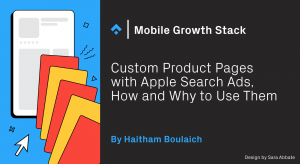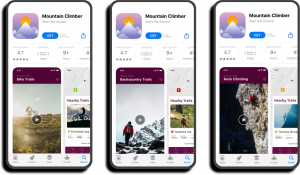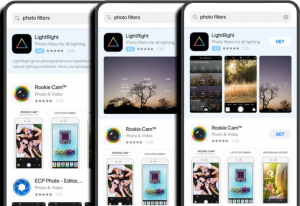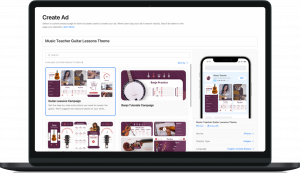
Besides product page optimization, custom product pages (CPPs) were the biggest shift in App Store marketing this year as they signaled the end of single App Store pages per locale. CPPs are unique landing pages in the App Store intended for user acquisition. From performance marketing channels to the App Store, they enable you to showcase different app features while maintaining consistent messaging and a seamless user acquisition journey.

[Source: Apple]
CPPs can be created with promotional text, screenshots, and app previews that are different from the ones on the default product page. The general guidelines are:
- Up to 35 custom product pages at once per app.
- Each is accessed via a unique URL link that directs traffic to the custom page.
- Mobile management partners are integrating CPPs into their tracker links, and ad networks are expected to integrate CPPs to make them accessible via app campaigns (CPPs are already accessible in Apple Search Ads [ASA]).
- Only 3 assets can be changed:
- Screenshots
- App previews
- Promotional text (top of the full description)
- No changes to the icon or text medata.
Each CPP has a unique URL, which can be integrated into ASA and used to direct traffic from a particular ad group to a specific CPP. It’s important to note that CPPs are not accessible to users searching organically. Instead, they’re only accessible via the unique URL that’s embedded in your performance marketing campaigns, or via the App Store’s curated selections on the Today, Games, and Apps tabs.
Custom product pages enable you to direct traffic from an ad group that targets a specific audience or user intent to App Store creatives that match their expectations. This more consistent and personalized user acquisition journey means that they’ll likely find your CPP more relevant than the default product page, which could lead to higher conversion rates.
Higher conversion rate could start as early as the tap-through-rate, as in the ASA ad will appear app previews from the CPP, not the default product page.

[Image caption: App previews in the ad will also be customized through the CPPs.]
In ASA, integration with CPPs happens at the ad group level. In the native console, under Ads, you can create ad variations, which is basically directing traffic from the ad to a specific CPP, instead of the default product page. Once in the Create Ad page, you can also target a particular device or language, and decide whether the ad will display preview images or only text.
Apple Search Ads offers the possibility to have both the default ad and the CPP ad running in the same ad group, this way you can initially compare the performance of both.

[Image caption: By creating ad variations, you can choose to which CPP you will direct traffic. The ad will also use screenshots and app previews from your CPP. Source: Apple]
Some specific use cases of CPPs could be:
- Showcasing different app features, e.g., yoga vs. HIIT workout on a fitness app.
- Directing traffic to a CPP that is more geographically relevant to specific users, e.g., a delivery app operating in Berlin could direct traffic from Berlin to a CPP with creatives that showcase the city.
- Targeting a specific demographic, e.g., a clothing app showing a different CPP for women vs. men.
- Leveraging seasonal campaigns, e.g., a Black Friday custom product page.
- Directing returning users to a CPP with a focus on new app features .
In ASA, most apps struggle with the scale and performance of non-brand keywords due to their lower relevancy when compared with brand keywords.
CPPs will enable you to better contextualize the user journey of the traffic caught with non-brand keywords; users will find each step of the funnel more relevant; this could boost conversion rates of these keywords. Due to higher conversion rates the performance of these keywords will improve, which will allow you to bid higher, be more competitive in the auctions, and acquire a higher impression share for these keywords. Consequently, this will increase the scale of these keywords.
Not taking advantage of CPPs would mean not being able to properly contextualize the full user journey. This would be a lost opportunity from your side and an opportunity that your competitors may very well take advantage of to optimize their user acquisition. For the record, CPPs could be leveraged to direct traffic from other advertising channels, not only from ASA. Other channels are able to also leverage CPPs, as long as they offer the possibility to embed a URL link in their campaigns or ad sets to push traffic to a specific CPP. The biggest paid social advertising channels such as Facebook, Snapchat, and TikTok use URLs to set up where the user will land after tapping on the ad, and in theory would support the CPP feature. Google App Campaigns doesn’t offer that possibility yet, and even though Google Search Campaigns uses a URL to indicate the landing page of the ad, it is not possible to embed an App Store URL in this case.
Here at the Phiture, we’re always happy to receive comments and feedback from our readers. If you have any follow-up questions or would perhaps like to recommend some additional reading or frameworks, don’t hesitate to get in touch.












